By Craig Halford
Managing Director at Jactone Products Limited
Historically, the fire protection of small energised enclosures has in many cases been an imprecise and non-certifiable area within the fire protection industry, due to the lack of specific performance standards.
For this reason, the default position has been systems certified to European Standard EN 15004, its international equivalents and extrapolations of them.
This has been an unsatisfactory situation since the confirmation of performance when protecting small enclosures has relied on manufacturers own testing without the 3rd party approval, essential for full acceptance in the market.
With the publication of NEW LPCB standard LPS1666 in January 2017, the landscape for certification of systems in this area has changed.
Below is a discussion highlighting the characteristics of systems certified to both BS EN 15004 and LPS1666, detailing both historical limitations and improvements now available in the protection of small energised electrical enclosures.
OPTION 1 : BS EN 15004
 Detection
Detection
In order to detect fire in an enclosure the room fire suppression system will require to utilise sensitive detection devices to trigger the system. In well sealed enclosures there will be very limited egress of combustion products / heat from the enclosure (some enclosures have high IP ratings for purposes of equipment protection).
Extinguishing Performance
Due to electrical enclosure seals, the chances of extinguishing the fire are reduced, due to insufficient penetration of extinguishant into the enclosure.
Limited effectiveness against fire spread
Room suppression systems will most likely only prevent breakout of fire from the room, not each individual electrical enclosure. Furthermore, migration of fire from one enclosure to the neighbouring enclosure(s) will not be prevented.
In summary, room suppression systems will require sensitive detection to detect deep seated fires in any individual enclosures and the possibilities to extinguish fires and prevent fire spread between those enclosures will be limited.
OPTION 2 : LPS1666 – The PAFSS Solution
 Detection : Basic – Tube Detection and Discharge
Detection : Basic – Tube Detection and Discharge
Due to its proximity to any fire or high ambient temperature, this will operate at least as efficiently within the cabinet as a much more sensitive detection device positioned outside the cabinet – Refer to Option 1.
Extinguishing Performance
Since discharge is directly into the cabinet, there is a much greater possibility that the fire will be extinguished, compared to Option 1. Discharge of extinguishant is inside the cabinet and therefore right at the heart of the problem. Early detection and system discharge means the fire is extinguished at an earlier stage in its development. This minimises equipment damage and generation of combustion by-products.
Effectiveness against fire spread
Just as importantly, PAFSS Systems are able to prevent migration of the fire between cabinets e.g. from Enclosure 1 > 2 > 3 > 4
LPS1666 : Certification Criteria

> Fire extinguishing performance based on maximum enclosure volume(s).
> Range of operation for system pressure and temperature.
> Detection and activation characteristics – Tube burst, proximity.
> System limits for detection tube length.
> Fully installed system leak characteristics.
> Maximum and minimum system temperature discharge characteristics.
> System installation limits.
> Full system component testing – Corrosion, Pressure Strength, Leakage, Corrosion,
> Ageing and System Monitoring devices.
> Protocols for servicing and maintenance of systems, together with approval of the manufacturers training programme.
Jactone PAFSS® : Enhanced Protection
Jactone PAFSS – First system in the world to be certified to LPS1666
Important : Provision is contained within the LPS1666 standard to confirm system fire extinguishing performance for installations that have (within limits) both :
Ventilation (Enclosed or Open Vents) and Airflow (Forced / Natural)
Jactone has a PAFSS system certified to LPS1666 with design allowance for BOTH. It is essential to discuss this issue when enquiring about the certification status of a particular system.
> You can download this document as a pdf here
> You can read more about PAFSS LPS1666 approved systems here


